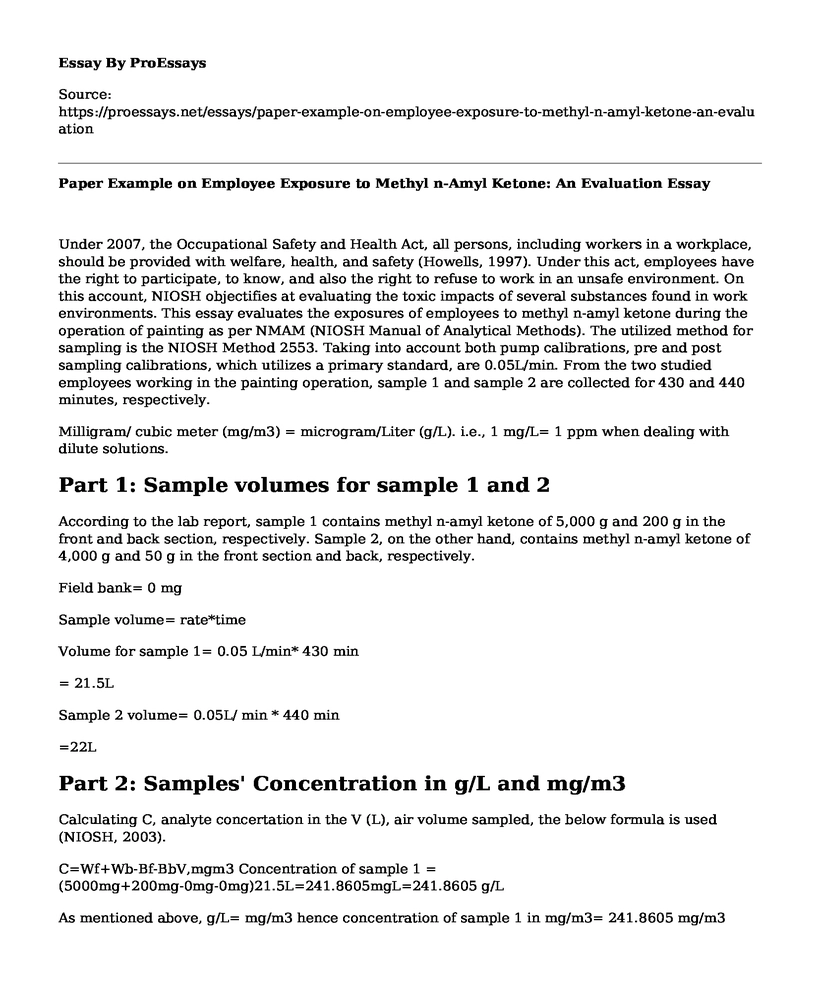Under 2007, the Occupational Safety and Health Act, all persons, including workers in a workplace, should be provided with welfare, health, and safety (Howells, 1997). Under this act, employees have the right to participate, to know, and also the right to refuse to work in an unsafe environment. On this account, NIOSH objectifies at evaluating the toxic impacts of several substances found in work environments. This essay evaluates the exposures of employees to methyl n-amyl ketone during the operation of painting as per NMAM (NIOSH Manual of Analytical Methods). The utilized method for sampling is the NIOSH Method 2553. Taking into account both pump calibrations, pre and post sampling calibrations, which utilizes a primary standard, are 0.05L/min. From the two studied employees working in the painting operation, sample 1 and sample 2 are collected for 430 and 440 minutes, respectively.
Milligram/ cubic meter (mg/m3) = microgram/Liter (g/L). i.e., 1 mg/L= 1 ppm when dealing with dilute solutions.
Part 1: Sample volumes for sample 1 and 2
According to the lab report, sample 1 contains methyl n-amyl ketone of 5,000 g and 200 g in the front and back section, respectively. Sample 2, on the other hand, contains methyl n-amyl ketone of 4,000 g and 50 g in the front section and back, respectively.
Field bank= 0 mg
Sample volume= rate*time
Volume for sample 1= 0.05 L/min* 430 min
= 21.5L
Sample 2 volume= 0.05L/ min * 440 min
=22L
Part 2: Samples' Concentration in g/L and mg/m3
Calculating C, analyte concertation in the V (L), air volume sampled, the below formula is used (NIOSH, 2003).
C=Wf+Wb-Bf-BbV,mgm3 Concentration of sample 1 = (5000mg+200mg-0mg-0mg)21.5L=241.8605mgL=241.8605 g/L
As mentioned above, g/L= mg/m3 hence concentration of sample 1 in mg/m3= 241.8605 mg/m3
Concentration of sample 2= (4000mg+50mg-0mg-0mg)22L=184.0909mgL= 184. 0909g/L= 184.0909mg/m3
Converting to ppm
Molecular weight for methyl n-amyl ketone = 114.2
Note: the ideal gas constant to be used =24.45.
Concentration of samples to ppm= ideal gas constant* TVL mg/m3/ Molecular weight for methyl n-amyl ketone
Concentration of sample 1 in ppm= 24.45* 241.8605/ 114.2= 51.7819ppm
Concentration of sample 2 in ppm= 24.45* 184. 0909/114.2= 39.4135ppm
Part 3: Results Analysis
Examining the above two concentrations (51.7819ppm and 39.4132), both are below the 100ppm OSHA PEL exposure limits (NIOSH, 2003). On this account, the implemented method to determine the exposures rate of employees to toxic substances (methyl n-amyl ketone) during a painting operation, NIOSH Method 2553 is recommended as the methyl n-amyl ketone exposure limits of NIOSH REL is equal to that of OSHA PEL as per NIOSH (2003). In general, the implemented sampling method (NIOSH Method 2553) involved trapping and retaining methyl n-amyl ketone by utilizing a solid sorbent tube with no change of composition. The collected air samples at a flow rate of 0.05 L/min were collected for 430 and 440 minutes for sample 1 and sample 2, respectively. Later, according to NIOSH (2003), a 1.0mL of 2% carbon disulfide or isopropanol solution is utilized mainly to release the compound of interest from the sorbent. The methyl n-amyl ketone exposure limits as per ACGIH TLV, on the other hand, is 50ppm.
Part 4: Discussion and Recommendation
As mentioned above, the results obtained for samples 1 and 2 were both lower than the methyl n-amyl ketone TVL ppm value of NIOSH REL and OSHA PEL exposure limits. Thus, the working environments for the painting operation appear safe and healthy for employees. The concentration of sample 1 is above the exposure limit when using ACGIH TLV, while that of sample 2 is lower. I would recommend the results to be compared with ACGIH TLV as it has a stricter exposure limit of 50ppm as compared to the limit of OSHA PEL, which is 100pm. A stricter exposure limit will always make sure the employees' and all person's welfare, health, and safety within the company are taken into consideration and is within legal limits.
References
Howells, R. (1997). Occupational health and safety law. M+ E. https://pdfs.semanticscholar.org/7503/5f29a3d949b6d27e711fa19f7d82b22b9e53.pdf
National Institute for Occupational Safety and Health. (2003). Ketones II: Method 2553. In P. M. Eiler & M. E. Cassinelli (Eds.), NIOSH manual of analytical methods (4th ed.). Retrieved from http://www.cdc.gov/niosh/docs/2003-154/pdfs/2553.pdf
Cite this page
Paper Example on Employee Exposure to Methyl n-Amyl Ketone: An Evaluation. (2023, May 21). Retrieved from https://proessays.net/essays/paper-example-on-employee-exposure-to-methyl-n-amyl-ketone-an-evaluation
If you are the original author of this essay and no longer wish to have it published on the ProEssays website, please click below to request its removal:
- Geography Essay Example: An Overview of the Australia
- Personal Beliefs and Values: Nursing Essay Example
- Essay Sample on Nursing Education
- Paper Example on Maximizing Employee Development for Improved Performance & Retention
- Essay on Motivating African American Males in Public Schools: Exploring the Role of Principals
- Essay Sample on Navigating Conflict: Unlock the Power of the Ladder of Inference
- Paper Sample on Social Distancing: An Effective Measure to Fight Coronavirus (COVID-19)







